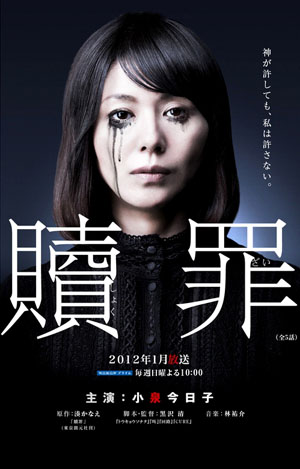Kiyoshi Kurosawa shot Shokuzai (Penance) for the WOWOW network, which aired the five-part mini-series in Japan back in January and February. Based on the 2009 novel by Kanae Minato, Penance will screen in full—that’s 270 minutes in all—Out of Competition in Venice, in the Contemporary World Cinema program in Toronto, and as a Zabaltegi Special at the San Sebastián Film Festival.
“The sense of creeping dread familiar to fans of Cure (1997) and other of Kurosawa’s pioneering J-horror films is still present,” writes Mark Schilling in a 3.5-out-5-star review for the Japan Times. “Also, the series is created more with his usual artfully minimal means—plastic bags blown eerily by the breeze, a translucent plastic sheet making strange shadows on the wall—than standard genre effects. At the same time, the story of a mother [Asako Adachi, played by Tokyo Sonata‘s Kyoko Koizumi] implacably seeking the killer of her young daughter may not please fans hoping for Kurosawa’s return to J-horror form, though its knowing explorations of the heart of darkness will be familiar to viewers of Tetsuya Nakashima’s Kokuhaku (Confessions) a 2010 film also based on Minato’s fiction.”
“There’s no way of avoiding the made-for-TV nature of the project,” finds the Playlist‘s Oliver Lyttelton. “In part it’s the production values, which are a little shaky in places, including the drab locations out of any police procedural, some HDCAM digital photography which varies from passable to genuinely ugly, and a horrible score that insists on telegraphing every moment of suspense, drama or comedy about 30 seconds in advance. But for the most part, it’s the structure. Each episode essentially works as a stand-alone short story, with only the shared backstory and Asako’s presence linking the five. And one certainly suspects that Penance would work better when seen over five days, or five weeks, rather than in one marathon sitting. However, it’s also a remarkably consistent and enjoyable piece of work.”
“Audiences will yearn for closure to this tale as much as the protagonists do,” writes Deborah Young in the Hollywood Reporter, “but the final chapter, ‘Atonement,’ is a mixed bag. Asako takes center stage, the police finally step in, and mysteries are solved in a David Lynch-like finale. Yet the satisfaction remains cerebral, not visceral, and the film’s paradoxical end leaves mainly a cold feeling of admiration for the excellent cast, the nuanced female roles, the cinematic appeal of the art direction and photography based on variations of the color white, the unexpectedness of Yusuki Hayashi’s score and the boldness of the whole project.”
Update, 8/31: Daniel Kasman in MUBI’s Notebook: “Kurosawa overlaps the worlds of Franju—uncanny materiality, extensive dramatic flatness and surrealist lyrical imagery—with that of Ruiz—belonging to a tradition of folklore and fables that’s self-perpetuating—to engage the television format by positing a world of endless, haunted storytelling.”
Update, 9/3: “Penance simply isn’t very good television,” writes Michael Sicinski for Cinema Scope, “and it certainly can’t hold a candle to the likes of Cure (1997), Pulse (2001), or even an uneven effort like Bright Future (2003). Most of the ‘action’ consists of endless dialogue and exposition in underlit rooms; apart from some brooding grey Tokyo skylines and an eye for modernist furnishings, there is nothing deep in the formal bones of Penance to distinguish it as the work of a master filmmaker.”
Update, 9/15: For Twitch‘s Todd Brown, “taken on their individual merits each episode is meticulously well constructed and beautifully performed. Kurosawa has always been a director fascinated with the consequences of isolation and Penance plays right into those strengths.”
Update, 9/17: “The first three parts of the film work very well,” writes Jordan Cronk at the House Next Door. “The first and most familiar episode sees Kurosawa infuse his slow-burn drama with violent and psychosexual imagery, while the second and third chart the physical and spiritual forces each woman must confront to gain atonement. But from there things take a nosedive. Kurosawa attempts to shoehorn humor into the fourth chapter, forfeiting nearly all the momentum of the prior chapters, which are more closely related to the thriller template. Meanwhile, the final chapter takes the grieving mother on a mission for revenge, contorting through plot contrivances and twists that make less and less thematic sense the further one steps back from the individual stories.”
Venice and Toronto 2012: a guide to the coverage of the coverage. For news and tips throughout the day every day, follow @KeyframeDaily on Twitter and/or the RSS feed. Get Keyframe Daily in your inbox by signing in at fandor.com/daily.




